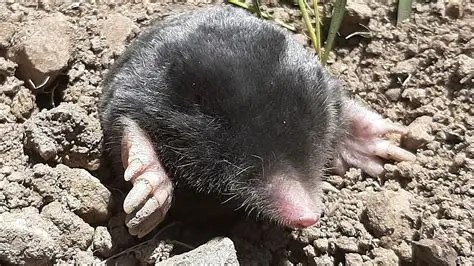Moles can be a gardener’s worst nightmare, wreaking havoc beneath the soil while remaining unseen. Their tunneling disrupts plant roots and can lead to unsightly mounds on the surface. Understanding how to effectively remove moles from your garden is essential for maintaining a healthy landscape. This article provides a comprehensive guide on mole removal, covering natural methods, chemical options, and preventative measures to help you reclaim your garden.
Understanding Moles in the Garden
Moles are small, burrowing mammals known for their velvety fur, spade-like hands, and cylindrical bodies. They primarily feed on insects and larvae, which can be beneficial for soil aeration but detrimental to delicate garden plants when their tunneling becomes excessive.
Signs of Mole Activity
- Visible mounds of soil on the surface, often shaped like volcanoes.
- Raised ridges in the lawn or garden bed indicating tunnels just below the surface.
- Damaged plant roots and wilting vegetation due to underground disturbances.
Why Moles Invade Gardens
Moles are attracted to gardens primarily for food. They thrive on earthworms, grubs, and other insects found in moist, nutrient-rich soil. A garden with ample food sources and loose soil becomes an ideal habitat for these creatures.
Step-by-Step: How to Get Rid of Moles in Your Garden
Natural and Humane Mole Removal Methods
Using natural methods is often the most humane way to deal with moles. Here are three effective options:
1. Castor Oil Repellent
Castor oil is a natural deterrent for moles. The oil disrupts their digestive system and makes the soil less appealing.
Ingredients: 1 cup of castor oil, 1 cup of dish soap, 5 gallons of water.
Instructions:
Mix castor oil and dish soap in a bucket.
Add water and stir well.
Pour the mixture into mole tunnels and around the garden perimeter.
Pros: Non-toxic and safe for pets.
Cons: Requires repeated applications, especially after rain.
2. Ultrasonic Repellers
Ultrasonic devices emit high-frequency sounds that are unpleasant for moles but inaudible to humans.
Instructions:
Place the device in areas with high mole activity.
Ensure it is powered and functioning properly.
Pros: Environmentally friendly and requires minimal maintenance.
Cons: Effectiveness may vary based on soil type and installation.
3. Natural Predators
Encouraging natural predators like owls and hawks can help control mole populations.
Instructions:
Install owl boxes or perches to attract these birds.
Avoid using harmful pesticides that could deter them.
Pros: Sustainable and promotes biodiversity.
Cons: Takes time for predators to establish in the area.
Chemical and Commercial Mole Control Options
If natural methods fail, consider chemical options with caution. Here are two commonly used methods:
1. Poison Baits
Commercially available poison baits can effectively eliminate moles but must be used with care.
- Instructions:
- Identify active mole tunnels.
- Place the bait inside the tunnels according to package instructions.
- Safety Notes: Keep pets and children away from treated areas.
- Pros: Quick results.
- Cons: Risk of harming non-target species.
2. Traps
Trapping is a more humane and effective method of mole control.
- Instructions:
- Purchase a mole trap designed for your garden type.
- Set the trap in an active tunnel, ensuring it is secure and properly positioned.
- Check traps daily and follow manufacturer guidelines for disposal.
- Safety Notes: Wear gloves to avoid leaving scent on traps.
- Pros: Directly targets moles without chemicals.
- Cons: Requires knowledge of proper trap placement.
Preventing Future Mole Problems
Once you have successfully removed moles, it’s essential to prevent their return. Here are several strategies to keep your garden mole-free:
- Maintain healthy soil by regularly aerating and enriching it, making it less attractive to moles.
- Reduce moisture levels in your garden, as moles prefer damp environments.
- Implement barriers, such as underground fencing, to deter moles from entering your garden.
- Monitor for signs of mole activity regularly to catch any new infestations early.
Essential Tools and Safety Tips for Mole Removal
Having the right tools can make mole removal more efficient and safer. Here’s a list of essential items:
- Gloves: Protect your hands while handling traps and chemicals.
- Shovel or trowel: Useful for digging and inspecting tunnels.
- Traps: Choose from various types according to your preferred method.
- Castor oil and dish soap: For natural repellent solutions.
- Ultrasonic repellers: For a non-invasive approach.
Safety Tips
- Always read and follow label instructions when using chemicals.
- Store poisons and traps out of reach of children and pets.
- Wear protective gear when handling traps or chemicals.
Seasonal Checklist for Mole Control
Monitoring and maintaining your garden throughout the year can help prevent mole problems. Here is a seasonal checklist:
Spring
- Inspect for signs of mole activity after winter.
- Apply natural repellents if moles are detected.
Summer
- Check for damage to plants and monitor for new mole activity.
- Consider installing traps in active areas.
Fall
- Prepare your garden for winter by aerating the soil.
- Continue to monitor for signs of moles before the ground freezes.
Winter
- Inspect for any visible mounds or activity signs.
- Plan for spring treatments based on previous observations.
Common Issues and Solutions
Even with the best intentions, mole control can sometimes be challenging. Here are common issues and their solutions:
- Persistent Mole Activity:
- Solution: Combine multiple methods, such as trapping and natural repellents, for better results.
- Traps Not Working:
- Solution: Ensure traps are placed in active tunnels and follow setup instructions carefully.
- Damage Misidentified:
- Solution: Differentiate mole damage from other pests by looking for specific signs like the structure of the mounds and the type of tunneling.
By understanding the habits of moles and employing effective removal and prevention strategies, you can protect your garden from these elusive garden pests. Regular monitoring and maintenance are key to ensuring a healthy, mole-free landscape.
